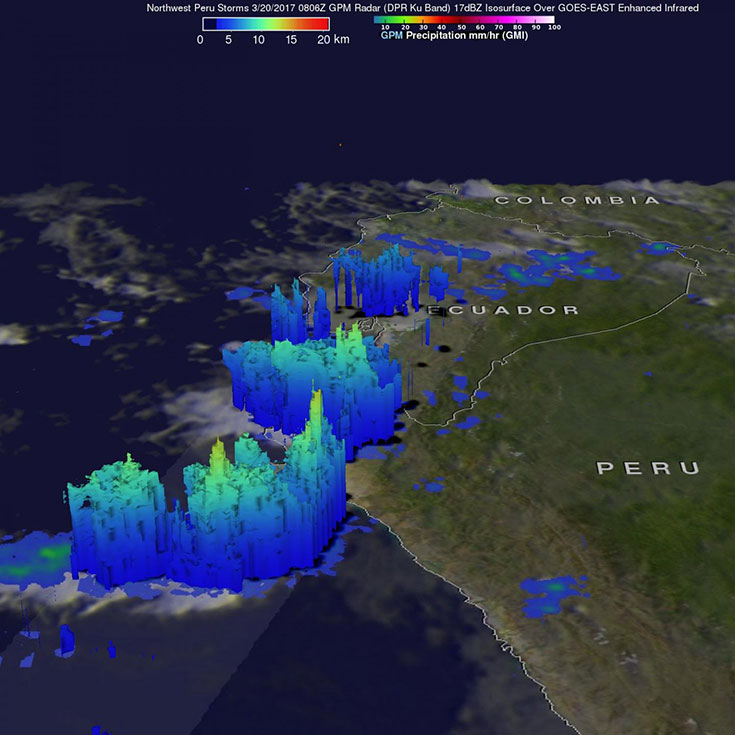NASA examine's Peru's deadly rainfall
More than 80 people have been killed and 110,000 displaced by heavy rain-related incidents in Peru since December. Rivers burst their banks, bridges collapsed and mudslides caused extensive damage.

Several storms located in the Pacific had cloud tops that were reaching altitudes above 13km. The United Nations Special Representative of the Secretary-General for Disaster Risk Reduction, Robert Glasser, said that the disaster highlights the challenges of a warming planet (image: NASA/JAXA/Hal Pierce)
Parts of the country, including Lima, experienced running water disruption after treatment plants became clogged with mudslide debris. Some markets have seen food supplies run short, as flooding and rainfall have damaged transport infrastructure.
On March 16, the country’s Northern coast saw extensive floods and landslides, and the government declared a state of emergency in 11 departments.
NASA’s Goddard Space Flight Center has taken data obtained by the Global Precipitation Measurement (GPM) mission and made it into an animation that shows exactly how heavy the rainfall has been (click here for animation). The cause of the storms has been attributed to warm ocean waters developing near Peru’s coast, causing an effect like El Niño.
The GPM, a joint mission between NASA and the Japanese space agency JAXA, is a constellation of satellites that provide data on precipitation rates and totals. Its core observatory flight flew above Peru on March 20 and identified the locations of storms that were dropping heavy rainfall over North-western Peru. The GPM’s radar data indicated that some storms were dropping rain at more than 137mm per hour.
UN Special Representative of the Secretary-General for Disaster Risk Reduction, Robert Glasser, commented: “Few countries were better prepared for the recent global El Niño than Peru, so it is doubly concerning that the country has been overwhelmed by this occurrence of local El Niño-like conditions which have flipped the country from widespread drought to enormous flooding that has taken dozens of lives, affected over half a million people and left many homeless.
“This is a large scale singular event which needs to be viewed in the context of a warming planet where episodes of extreme weather variability are becoming more evident. Just a few months ago Peru was suffering from a drought and record wildfires and now, according to Peru’s National Emergency Operations Centre, 75 people have lost their lives in floods, many are missing, and over 625,000 people are affected including more than 70,000 who have lost their homes.
“If we are to succeed in preventing disasters like this and to reduce disaster losses then we need to ensure that there is a much broader understanding of the nature of disaster risk in society at large and this includes better understanding of the impacts of climate change and how it alters local weather patterns. Risk has to be addressed in local development plans.
“Multi-hazard early warning systems must include estimates of the potential impact of the emerging hazards and be tailored to local needs. This will be a key issue at the Global Platform for Disaster Risk Reduction which will be held in Mexico in May.”